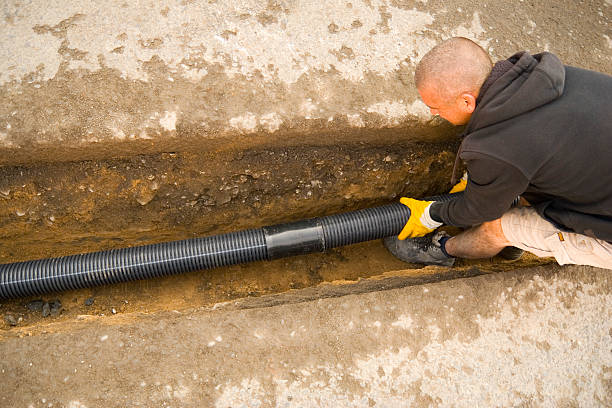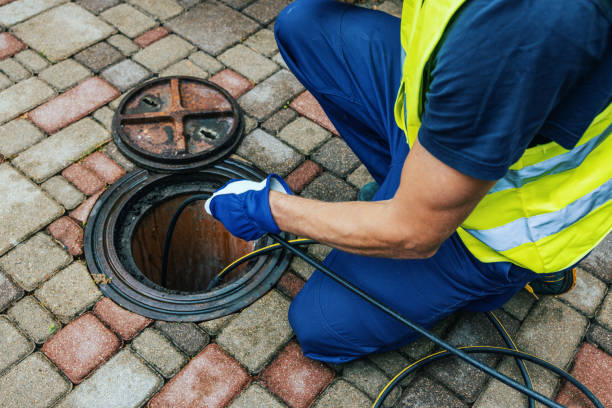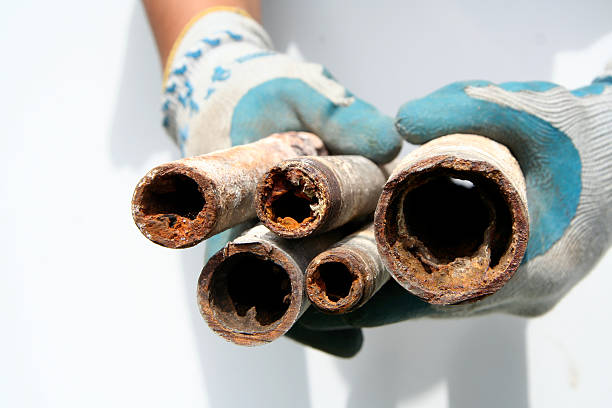
Underground drainage pipes are essential for keeping your drainage system in good working order. They ensure that water is efficiently carried away from your property, preventing potential damage from water buildup. This article will cover everything you need to know about underground drainage pipes, including the different types available, their components, common problems to watch out for, installation and maintenance tips, and important factors to consider for effective water flow.
In this article, you will discover:
The various types of underground drainage pipes.
Key components that make up an efficient underground drainage system.
Installation and maintenance best practices.
Specific challenges for underground drainage in Houston.
Key Takeaway: Understanding the key aspects of underground drainage pipes is crucial for maintaining the integrity of your property’s drainage system.
For professional plumbing services in Houston, Vossler Plumbing offers a team of skilled plumbers who can provide the expertise you need. Additionally, if you’re considering upgrading to a more efficient water heating system, you may want to explore tankless water heaters, which offer benefits such as energy savings and continuous hot water supply.
When it comes to underground drainage pipes, plastic options like PVC (Polyvinyl Chloride) and HDPE (High-Density Polyethylene) are among the most commonly used materials. These materials are popular due to their versatility and effectiveness in various drainage applications.
Plastic pipes offer numerous benefits that make them highly suitable for underground drainage systems:
PVC Underground Drainage Pipe: Known for its rigidity and strength, PVC is a popular choice for both residential and commercial underground drainage systems. It is often used as a principal drainage pipe in sewer systems and rainwater drainage setups.
HDPE Piping: HDPE is valued for its flexibility and high resistance to impact and chemicals, making it suitable for challenging environments. This type of pipe material is frequently utilized in areas prone to ground movement or where chemical resistance is paramount.
Plastic pipes offer numerous benefits that make them highly suitable for underground drainage systems:
Durability: Both PVC and HDPE pipes exhibit excellent durability, capable of withstanding harsh environmental conditions without deteriorating.
Corrosion Resistance: Unlike metal pipes, plastic pipes do not corrode over time, ensuring a longer lifespan and reduced maintenance costs.
Lightweight: The lightweight nature of plastic pipes makes them easier to handle and install compared to heavier materials like concrete or cast iron.
Smooth Inner Surface: The smooth interior surface of plastic pipes reduces friction, allowing for efficient water flow and minimizing the risk of blockages.
While plastic pipes have many benefits, there are some drawbacks to be aware of:
Thermal Expansion: Plastic pipes can expand and contract with temperature changes. This thermal expansion may require additional considerations during installation.
Potential for Damage from Heavy Loads: While durable, plastic pipes can be susceptible to damage from heavy loads or impacts if not properly protected or installed at an adequate depth.
Concrete, clay, and cast iron are viable alternatives depending on specific use cases. Each material offers unique properties:
Concrete Pipes: Highly durable and ideal for large-scale drainage projects but require significant labor to install due to their weight.
Clay Pipes: Traditional option known for its longevity but less common today due to the availability of more advanced materials.
Cast Iron Pipes: Strong and long-lasting but prone to corrosion without proper coating; often used in specialized industrial applications.
For reliable solutions tailored to your needs, you can explore drain and sewer services in Houston that offer a range of options including hydro jetting services for thorough cleaning, probiotic drain cleaners as a sustainable solution to clogged drains, and even energy-saving water heaters like tankless systems to help you save costs in the long run.”.
Concrete, clay, and cast iron are alternative materials commonly used for underground drainage pipes. Each of these materials has specific use cases and benefits that make them suitable for particular applications.
Durability: Concrete pipes are known for their long lifespan and strength, making them ideal for large-scale infrastructure projects.
Load-bearing capacity: These pipes can handle heavy loads, which is beneficial in areas with heavy traffic.
Resistance to corrosion: Concrete is naturally resistant to many types of corrosion, providing a robust option for sewer pipes.
Eco-friendly: Clay pipes are made from natural materials, making them an environmentally friendly choice.
Chemical resistance: They offer excellent resistance to chemical degradation, ensuring longevity in various soil conditions.
Historical use: Due to their long history of use, clay pipes have proven reliability in traditional drainage systems.
Strength: Cast iron pipes are extremely strong and can withstand significant internal and external pressures.
Noise reduction: These pipes help minimize the noise from flowing water, an added benefit in residential areas.
Fire resistance: Cast iron’s natural fire-resistant properties make it a safer option in certain scenarios.
Choosing the right type of pipe material is crucial for ensuring the effectiveness and durability of your principal drainage pipe system. While plastic pipes like PVC underground drainage pipe and HDPE piping are popular for their flexibility and ease of installation, concrete, clay, and cast iron offer unique advantages for specific needs. For more detailed information on choosing the right materials, you can refer to Vossler Plumbing’s comprehensive Plumbing Blog or explore their top-notch Plumbing Repair Service offerings in Houston, Texas.

An underground drainage system is a complex network designed to manage wastewater effectively, preventing the accumulation of toxins and bacteria. Key components include:
Drainage Pipes: Essential for transporting water away from buildings. These pipes are typically made from PVC, HDPE, concrete, clay, or cast iron.
Catch Basins: Collect surface water and debris, preventing clogs in the drainage pipes.
Inspection Chambers: Allow for easy access to the drainage system for maintenance and inspection.
Soil and Vent Pipes: Ensure proper air circulation within the drainage system to maintain pressure balance.
Sump Pumps: Remove accumulated water from low-lying areas.
Effective integration of these components ensures optimal performance of your underground drainage system. To further enhance the functionality of your system, consider availing water systems and heater services in Houston that guarantee a clean, safe, and comfortable water supply along with efficient heating solutions.
Additionally, it’s crucial to be aware of potential issues that may arise during winter. Don’t let common winter plumbing problems catch you off guard; our comprehensive guide provides expert tips and preventive measures to help you avoid them.
Correctly installing underground drainage pipes is crucial for effective ground water drainage and preventing future issues. Follow these steps for a successful installation:
Planning and Preparation: Assess the drainage requirements of your property. Determine the pipe route, taking into account the natural slope of the land.
Excavation: Dig a trench along the planned route. The trench should be deep enough to accommodate the pipe and any necessary backfill material. Ensure the trench is wide enough to allow easy maneuvering during installation.
Pipe Slope: Maintain a consistent slope to ensure proper water flow. A general rule is to have a slope of 1/8 inch per foot. Use a level or a laser level to check the slope periodically.
Laying the Pipe: Place a layer of gravel at the bottom of the trench to provide a stable base. Lay the drainage pipe on top of the gravel, ensuring it follows the slope.
Joint Connections: Securely connect each section of pipe using appropriate fittings. Use PVC cement or rubber gasket joints for plastic pipes, depending on the type you are using.
Backfilling: Cover the pipe with gravel or another suitable backfill material up to several inches above the pipe. Complete backfilling with soil, compacting it periodically to avoid future sinkholes.
Inspection and Testing: Inspect all connections and ensure there are no visible leaks. Test the system by running water through it to confirm proper flow and drainage.
Regular maintenance ensures that your underground drainage system remains efficient:
Inspections: Periodically inspect your drainage pipes for any signs of damage or blockages.
Cleaning: Remove debris from drainage grates and perform regular flushing of pipes to prevent clogs.
Seasonal Checks: Before winter, make sure your system is ready for freezing temperatures by checking for any insulation needs around pipes.
If you’re in Houston and need professional help with plumbing repairs, visit Plumbing Repair Near Me in Houston for expert assistance.
For more detailed guidance on preparing your home plumbing systems, especially during hurricane season, check out our comprehensive Hurricane Season Prep: Top 10 Plumbing Checklist.
Remember, if you reside in Galveston, Texas, our best plumbing services in Galveston are available to cater to your needs.
Regular maintenance is crucial to ensure the longevity and functionality of your underground drainage pipes. Neglecting maintenance can lead to clogs, blockages, and eventually costly repairs. Here are some essential guidelines:
Regularly inspect your underground drainage pipes for any signs of damage or blockages. This can prevent minor issues from escalating into major problems. Use a camera inspection tool to get a clear view inside the pipes without excavation.
Periodic cleaning of the pipes helps in maintaining optimal water flow. Use high-pressure water jets or mechanical cleaning tools to remove debris, sediment, and other obstructions that could impede drainage.
Ensure that the pipe slope is consistent and correct as improper slopes can cause water pooling and inefficient drainage. This is particularly crucial in areas with high ground water levels.
Examine joint connections for any signs of leaks or wear. Proper sealing of joints ensures no ground water seepage into the system, which could compromise its efficiency.
Adhering to these maintenance practices not only enhances the performance of your drainage system but also prolongs its lifespan, saving you from expensive home maintenance costs.
To further avoid costly mistakes, consider implementing our comprehensive Home Maintenance Costs guide which outlines common errors that homeowners make and how to prevent them.
For those seeking year-round convenience and peace of mind, we offer a membership program at Vossler Plumbing. By joining our program, you gain access to regular maintenance checks and professional assistance tailored to your specific needs.
Remember, regular inspections and cleanings are key activities that will keep your underground drainage system functioning efficiently while preventing unwelcome surprises down the line.

Residents of Houston face unique challenges when dealing with underground drainage pipes. Local soil conditions, climate factors, and regulatory considerations all play a significant role in the effectiveness and longevity of these systems.
Houston’s soil is predominantly clay, which expands and contracts with moisture levels. This can lead to:
Pipe Shifting: Clay soil movement may cause pipes to shift, leading to misalignment or even breakage.
Increased Pressure: Expansion and contraction place additional stress on pipe joints and connections.
Houston experiences heavy rainfall, especially during hurricane season. This necessitates robust drainage solutions to handle large volumes of water quickly.
Flood Risk: The area’s low elevation and heavy rains increase flood risks, making efficient drainage crucial.
Humidity and Heat: High temperatures and humidity can affect materials, particularly plastic pipes, causing them to expand or degrade faster.
Local regulations also impact how you install and maintain underground drainage systems.
Permits Required: Specific permits may be needed for extensive excavation or new installations.
Code Compliance: Ensure your system meets local building codes and standards for safety and efficiency.
For more detailed assistance with these unique challenges, consider consulting professional services like those offered by Vossler Plumbing, who specialize in drain cleaning and maintenance tailored for Houston’s conditions.
Understanding these factors helps in planning a more resilient drainage system that stands up to Houston’s specific environmental and regulatory demands.
Understanding the key aspects of underground drainage pipes is crucial for maintaining the integrity of your property’s drainage system. These pipes play a significant role in ensuring effective water flow, preventing water damage, and maintaining a healthy environment around your property.
Key Role: Underground drainage pipes are essential for a well-functioning ground drainage system. They help manage excess water, protect foundations, and reduce soil erosion.
Taking Action: Implement the knowledge gained from this article to effectively manage your own drainage lines. Regular inspections, proper installation, and routine maintenance can prevent common issues and extend the lifespan of your system.
When in doubt, seek professional assistance to ensure your pipes drain efficiently and maintain optimal performance.
Whatever you’re experiencing, we have the technical expertise to help. Click below to share your information along with any specific details or photos, and we’ll be in touch with you as soon as possible with an estimate.